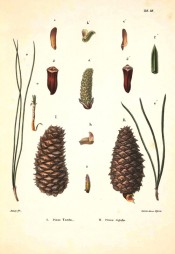Pinus taeda L.
Fully-hardy evergreen tree with bluish young shoots, long, slender, flexible and slightly twisted leaves, to 25cm long, and oblong cones, to 10cm long. To about 20m. Cultivated for timber and occasionally naturalised around plantations. [RHSD, Hortus, Hilliers’, FNSW].
Horticultural & Botanical History
Introduced to Britain in 1713. [JD]. ‘Pinus taeda L. Carolinian and Louisianian areas. Delaware to North Carolina and Florida west to eastern Texas and southern Arkansas. Alabama: Mountain region to Coast plain. From the coast to the Warrior tableland. Cullman County, 800 feet. Flowers early to latter part of March. Type locality: “Hab. in Virginiae, Canadae palidosis.” Economic uses: Important. Valuable timber tree; the largest among the Southern timber pines.’ [Contributions from the U.S. National Herbarium – Plant Life of Alabama v.6, p.323 /1901]. Leaves, female cones and seeds are figured in Die Coniferen. [Die Coniferen t.VII/1840-41].
History at Camden Park
Listed in the 1857 catalogue only [C.76/1857].
Notes
Pinus taeda Blanco (1837) = Pinus insularis Endl.
Published Jul 24, 2009 - 02:04 PM | Last updated Jul 29, 2010 - 03:26 PM
| Family | Pinaceae |
|---|---|
| Category | |
| Region of origin | Southern and eastern USA |
| Synonyms | |
| Common Name | Loblolly pine, Old field pine, Rosemary pine |
| Name in the Camden Park Record | Pinus Toda |
| Confidence level | high |


